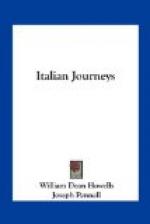The “Grande Illustrazione del Lombardo-Veneto” includes notice of all those dear and famous cities of North Italy which we know,—of Verona, Vicenza, Padua, Venice, Mantua, Modena, Brescia, Bergamo, and the rest; but here we have only to do with the part which concerns Mantua. This is written by the advocate Bartolomeo Arrighi, whose ingenious avoidance of all that might make his theme attractive could not be sufficiently celebrated here, and may therefore be left to the reader’s fancy. There is little in his paper to leaven statistical heaviness; and in recounting one of the most picturesque histories, he contrives to give merely a list of the events and a diagram of the scenes. Whatever illustrated character in princes or people he carefully excludes, and the raciness of anecdote and the flavor of manner and epoch distil not into his compilation from the elder historiographers. I have therefore to go back, in my present purpose, to the authors whose substance he has desiccated; and with their help, and that of one or two antiquated authors of this century, I shall try to rehabilitate the ducal state of Mantua,
“Which was an image of the mighty world,”
and present some shadow of its microcosmal life. The story has the completeness of a tragedy; but it runs over many centuries, and it ends like a farce, though it ends with a death. One feels, indeed, almost as great satisfaction in the catastrophe as the Mantuans themselves, who terminated their national existence and parted from their last Duke with something like exultation.
As I recall my own impressions of the city, I doubt if any good or bad fortune could rouse her to such positive emotion now. She seemed sunken, that dull April evening of our visit, into an abiding lethargy; as if perfect repose, and oblivion from the many-troubled past,—from the renown of all former famine, fire, intrigue, slaughter, and sack,—were to be preferred by the ghost of a once populous and haughty capital to the most splendid memories of national life. Certainly, the phantom of bygone Mantuan greatness did not haunt the idle tourists who strolled through her wide streets, enjoying their quiet beauty and regularity, and finding them, despite their empty, melancholy air, full of something that reminded of home. Coming from a land where there is a vast deal of length, breadth, and rectitude in streets, as well as human nature, they could not, of course, feel that wonder in the Mantuan avenues which inspired a Venetian ambassador, two centuries since, to write the Serenest Senate in praise of their marvelous extent and straightness; but they were still conscious of a certain expansive difference from Gothic Verona and narrow Venice. The windows of the ground-floors were grated to the prison-like effect common throughout Italy; but people evidently lived upon the ground-floors, and at many of the iron-barred windows fair young prisoners sat and looked out upon the streets, or




